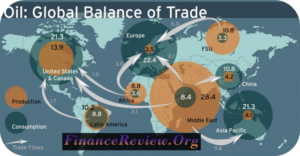Let us evaluate the latest International Energy Agency’s Staggering Excess Oil report that suggests oil producers’ continuous investment in new projects even after the net zero shift.
Highlights:
- The investment in new projects indicates the decade-end worldwide excessive oil challenge while having an exceptional oil surplus by 2030.
- One of the reasons driving oil growth is the switch to electric vehicles by industrialized nations, which use electricity more than oil.
- As a consequence of Staggering Excess Oil, the global sales of electric vehicles (EVs) will reach around forty million by 2030. The reports suggest this growth is due to one Electric Vehicle in each two-car sale.
Staggering Excess Oil:
Forecasts of energy watchdogs show that the spare oil capacity will reach its highest, and the world may experience the challenge. The globe’s largest oil consumers are among the members of the International Energy Agency.
As per the agency’s much-awaited medium-term oil market assessment, a surplus supply is the reason why prices could soar to levels last seen during the coronavirus or the COVID-19 outbreak in the upcoming years.
The Rising Demand For The Alternatives To Decreased Energy Emissions:
The demand for Electric Vehicles (EVS) demand will reach about ten times more about six years from now. Since 50% of vehicles sold by 2030 are expected to be electronic vehicles. The predictions also show that the lower energy emission alternatives have resulted in decreased crude oil demand across the planet.
Also, fifty percent of the worldwide demand for electricity will come from renewable energy sources, which is a thirty percent hike. The American region will also witness fifty percent of Electric Vehicle sales by 2030 since they are alternatives to decrease energy emissions.

The Need During Surplus Oil Period:
Many experts suggest that every nation must work on a crucial scenario where it will witness excessive oil. The nations must analyze and strategize the excessive oil scenario by using their best approaches.
However, cooperation between nations worldwide is a must to accelerate the transition to clean energy. Since the emissions are declining at greater speed, the global oil-driving nations find it challenging to finance solutions for sustainability. This challenge would not meet the rising needs and demands of energy for the rapidly rising economies across the globe.
The Triggering Factors: Staggering Excess Oil
- Global governments have boosted their renewable energy investments after the complete invasion of Ukraine by Russia. It was a response to the energy crisis and the climate change the nations’ conflicts sparked.
- Reducing the likelihood of a major supply shortage can be achieved in just a handful of months when citizens and governments across the globe and advanced economies take real steps.
- Oil usage will reach its peak by this decade’s end, while its usage for transportation worldwide will peak approximately in 2026. The reports suggest that it would get an equilibrium point for every application by 2028.
Conclusion:
The IEA recently mentioned the excessive oil challenge for the nations worldwide. Strategies were made for reducing oil use in response to Russia’s invasion over Ukraine. This measure reduced the market for petroleum supplies before the time for demand reached its highest.
Finance Review suggests that the best approach for Staggering Excess Oil would be to initiate efforts to avoid excessive oil, which is the wisest course of action.




GIPHY App Key not set. Please check settings